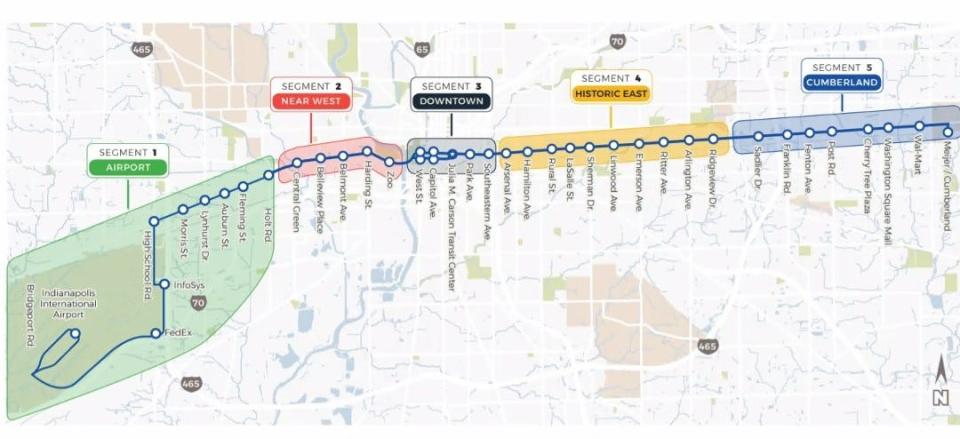Ballooning costs force IndyGo to rethink Blue Line design; here's what might change.
IndyGo is considering changes to the route for the Blue Line, the transit agency's third bus rapid transit line connecting Cumberland to the Indianapolis International Airport, in light of ballooning project cost estimates.
This summer, the transit agency received an updated cost estimate of $520 million to build five of six segments, compared to a 2019 cost estimate of $220 million for the entire 24-mile route along Washington Street.
To cut costs, IndyGo is proposing diverting the bus rapid transit route to I-70 between Holt Road and the airport, rather than using Washington Street. That would save in capital costs and travel time to the airport, but it would also mean no new stops west of Holt Road and no immediate infrastructure improvements to that stretch of Washington Street, unless the city or IndyGo pursues these in a separate project.
More:7-year-old's death makes Washington Street safety a flashpoint in battle over Blue Line
IndyGo is also considering using hybrid buses for the initial rollout of the Blue Line, rather than its previous plan to use all-electric buses.
Inflation among several factors in rising costs to IndyGo Blue Line
IndyGo began work on the Blue Line in 2018, and completed 30% of the design in 2019. At that milestone, IndyGo received a cost estimate of $220 million.

Work paused in late 2019 to focus on the Purple Line, the city's second bus rapid transit line that connects downtown to Lawrence and is scheduled to open in 2024.
In the spring of 2021, the design team resumed work on the Blue Line in earnest, excluding the segment between Holt Road and the airport, since this section had been the subject of various legislative proposals in the General Assembly to restrict the use of dedicated bus lanes. Upon reaching 60% design completion this spring, the updated cost estimate for the segments between Holt Road and Cumberland came out to $520 million.
"So we’re not even comparing apples to apples," chief development officer Jennifer Pyrz told the board.
Labor shortages and supply chain issues have increased construction costs in "unpredictable ways," she said, in addition to unprecedented levels of inflation.
Another major cost increase is attributable to city and Citizens Energy Group standards for drainage that have changed since work on the Blue Line began in 2018, Pyrz said. Drainage costs alone comprise 42% of the total construction cost, whereas they comprised 18% of the Purple and Red Line costs.
"Forty-two percent drainage on a transit project is way out of wack with where other transit projects are," Pyrz said.
Third, IndyGo now needs nearly twice as many buses for the Blue Line than it anticipated in 2018.
The U.S. National Defense Authorization Act of 2020 prevents IndyGo from using federal dollars to purchase buses from a China-based manufacturer such as BYD, from which it purchased electric buses for the Red and Purple Lines. That limits IndyGo's options to one other electric bus manufacturer, which Pyrz said costs more and has worse range.
Because those only travel half as far on a charge, IndyGo would need to purchase 55 instead of the original 29 planned.
What changes IndyGo is proposing
Shifting the rapid transit buses onto I-70 at Holt Road, instead of building the route on Washington Street to the airport, would save at least $50 million in capital costs alone. More than 80% of that was going to go toward drainage needs in the area.
It would also eliminate the need for about 5 buses and save operational costs of $1.6 million a year, IndyGo estimates.
Changing the route away from this section of Washington Street does not mean there won't be future work to improve pedestrian-friendly infrastructure in the area, Pyrz said.
IndyGo CEO Inez Evans said the agency is still committed to addressing those needs, with the caveat that the city would first need to address the severe drainage issues there.
IndyGo is in active talks about developing a microtransit program in the area, a door-to-door service for residents where transit access is lacking, Evans said.
"We’re still committed to helping that segment of our city," she said.
IndyGo also estimates it could save $96 million if it used hybrid buses for the initial rollout of the Blue Line rather than electric buses. Hybrid buses would last an expected 7-12 years, and at the end of their life, IndyGo's hope would be to switch to all-electric, Pyrz said.
IndyGo also plans to meet with the city Department of Public Works and Citizens Energy Group to see how they can save costs on the drainage and sewage requirements.
The project team plans to continue evaluating potential design changes and their impacts to federal grant eligibility, then present options to the board of directors in December.
"There’s a lot of decisions to be made," Pyrz said. "We have a very strong commitment to improving the service between Cumberland and the airport for our customers."
Contact IndyStar transportation reporter Kayla Dwyer at kdwyer@indystar.com or follow her on Twitter @kayla_dwyer17.
This article originally appeared on Indianapolis Star: IndyGo considers major changes to Blue Line amid budget concerns

